Download
in PDF Format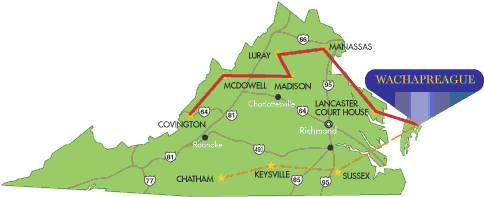
�The little city by the sea� is
A.K.A. the �Flounder capital of the world�
Drive across the Chesapeake Bay
Bridge-Tunnel and continue north till you�re about midway up
Virginia�s Eastern Shore. Turn right on Route 180, and go as far east as
you can go without getting wet.
Welcome to Wachapreague, the �Little
City by the Sea.� While the town often uses that nickname, in no way can
it be considered a city at all. With a population of about 250 full-time
residents, the town takes up only a smidgen of Virginia real estate �
but what real estate it is.
|
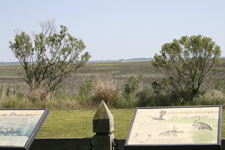
Standing
at the town's overlook, visitors can gaze upon the Virginia Coast
Biosphere Reserve. |
Entering town on Main Street, visitors
pass the two churches, post office, general store and town hall before
coming to the waterfront. There they are greeted with one of the most
beautiful vistas on the East Coast. There the Wachapreague Channel cuts a
winding trail through expansive salt marshes, out toward the uninhabited
barrier islands of Parramore and Cedar standing sentry at the entry to the
Atlantic Ocean. Throughout the area, commercial watermen ply their trade
while recreational fishermen experience some of the finest the sport has
to offer. Known to many as the �Flounder Capital of the World,� Wacha�preague
also offers other challenges, such as some of the best offshore fishing on
the eastern seaboard, including forays for tuna and marlin.
|
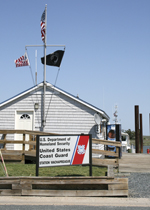
One
of the Coast Guard's smallest, but vitally important, small-boat
stations is located in Wachapreague. |
While fishing put Wachapreague on the
map, there�s much more to this seaside village, including a rich
history. It was in 1656 that the Algonquin Indian Emperor Wachiwampe
penned his last will and testament, leaving the land he referred to as
Wachapreague to his daughter. Less than a hundred years later, however,
the area had been settled by the family of one John Teackle and had become
known as Teackle�s Landing.
The national events of the time did
not bypass the fledgling community, however, and by 1779, makeshift forts
had been established on Parramore and Cedar islands. From these outposts,
defenders of the new country fired upon at least one British warship, the
sloop Thistle, forcing its sinking offshore.
Early in the next century, the Teackle
family fell on hard times and eventually their holdings were sold to Capt.
John Finney, whose family, in turn, sold 39 acres of the property to
George, John and Henry Powell, three men who were not only brothers, but
also astute businessmen. Soon, a little village known as Powellton sprung
up with a busy wharf as the hub of activity.
By 1884, the need for a post office
was evident; however, the petition for postal service for Powellton was
turned down, since that name was already in use elsewhere. Thus, it was
back to Wachapreague as the town�s moniker. Only a few years later, the
famous Wachapreague Hotel was built overlooking the water. This four-story
luxury accommodation became a preferred destination for vacationers from
the north � and at least one president, Herbert Hoover.
Sadly, in 1978, a fire left the hotel
ravaged and it had to be demolished. Today, the site of the Wachapreague
Hotel is owned by The Nature Conservancy, but an effort is underway by the
town to purchase the property for use as a town square. Despite
the loss of the hotel, other amenities still abound. Nearby, B&B
lovers can check into the Garrison Bed & Breakfast in Painter, which
also offers non-guest gourmet dining.
|
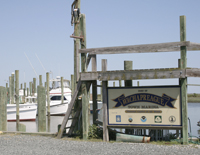
The
Wachapreague Marina provides safe mooring for visitors who arrive
by water. |
Waterside, the Wachapreague Motel
offers accommodations including rooms, efficiencies and two-bedroom
apartment. Meanwhile, the best seafood on the East Coast can be enjoyed at
Fish Tales at the wharf or at the Island House Restaurant overlooking the
barrier islands. At the Island House, host Randy Lewis ensures the
Shore�s finest seafood can be complimented by the Shore�s finest
wines. Wines from Bloxom Vineyard in Bloxom, Chatham Vineyards in
Machipongo and Holly Grove Vineyards in Franktown are all available.
Either � or all three � of the vineyards make excellent side trips
while visiting the area.
Bloxom Vineyard and Winery is a
35-acre Victorian farm with six acres of Chardonnay, Merlot and Cabernet
grapes and features a tasting room open on weekends. The Federal-period
home at Chatham Vineyards was begun in 1818 by Major Scarborough Pitts on
land on Church Creek first patented in 1640. The buildings on the property
reflect four centuries of continuous use as a working farm. The latest
addition is the winery built in 2005. In 1999, the first five-acre block
of grapes was planted and today there are more than 20 acres of French
Vinifera. The winery is open to the public with free tours and tastings.
Tours and tastings are available by appointment at the Holly Grove
Vineyards. Holly Grove�s 2006 vintage
Chardonnay was a Silver Medal winner in the 2007 Virginia Governor�s Cup
Wine Compe�tition,
and both the
2006 Chardonnay and 2006 Merlot were medal winners
in the 2008 Lodi International Wine Awards Competition. Their 2006 Merlot
and 2007 Sunset
Ros� were medal
winners in the National Women�s Wine competition in Santa Rosa, Calif.
Local art
While the fruit of the vine and the
bounty of the sea are both to be enjoyed dockside in Wachapreague, so too
is a sampling of the arts. Alex Russell Decoys is located on Main Street.
Russell has brought his own style to this age-old craft and features many
unique works as well as more traditional carvings. Another favorite
Wachapreague artist is Guy Wilkins. Wilkins describes himself as �an
Expressionist painter in the style that began in the early 20th century
and continues today.Although I paint the real world,� he says, �it is
a very personal and imaginative interpretation, leaning towards the
surreal.� Wilkins� work can be found in various shops in and around
Wachapreague, including the retail shop at the Island House.
Fishing�s the
thing
|
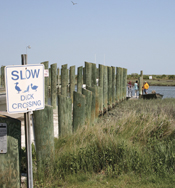
Wildlife
gets the respect it deserves. |
Still, it is the fishing that attracts
the most attention and there�s more than one way to enjoy the sport.
Boat ramps and slips are available for those who trailer their own
watercraft or who choose to arrive by sea. Skiffs with outboards are
available for rent, and charter boat captains welcome parties aboard for
half-day or day-long jaunts.
After a day of fishing, browsing the
numerous area antique shops or beachcombing on a barrier island, other
small-town amenities beckon, such as the town park with its children�s
playground, tennis courts and baseball field. There is the Wachapreague
Volunteer Fire Depart�ment�s
Annual Carnival with traditional rides, games and fantastic foods
including oyster fritters. Canoeists and kayakers can check out the
Virginia Seaside Water Trail, which runs between the Eastern Shore of
Virginia National Wildlife Refuge at Cape Charles and Chinco�teague
Island. There�s a floating dock at Wachapreague Harbor, and canoes and
kayaks are available for rent at a local shop.
A scenic overlook area on the
waterfront is a part of the Eastern Shore Loop of the Virginia Birding and
Wildlife Trail, as the area well should be. Having been protected from
development, the area has continued to be a vital part of the Atlantic
Flyway and, during migrations, can be seething with shorebirds, songbirds
and raptors that follow the coast on their flights.
International
acclaim
|
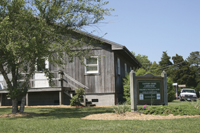
Scientific
research is a big part of what goes on in Wachapreague, where The
College of William and Mary manitains a facilities. The Eastern
Shore Laboritory (ESL) has become internationally knownm for its
important contributions to ecology. |
Other facets of coastal ecology are
also of importance in Wachapreague, where The College of William &
Mary�s Virginia Institute of Marine Science operates a field site in
support of research and teaching, as well as a resident research facility.
The Eastern Shore Laboratory (ESL) has become internationally known for
its important contributions to the science of ecology. The ESL maintains a
fleet of small vessels at its facility, which includes labs, dormitories,
classrooms and a library.
Also maintaining a small fleet in
Wachapreague is the United States Coast Guard. The service, which has a
rich history in the area, keeps a contingent on watch for
search-and-rescue and law-enforcement duties in the area. This small boat
station is the modern incarnation of the original Life Saving Service that
was housed in a stately facility on Parramore Island in days gone by.
While today�s modern boats,
laboratories and harbor facilities now occupy the Wachapreague waterfront,
it is still easy to imagine the Wachapreague of old � a town where folks
took a stroll or sat on their porch after dinner � where everyone you
met offered a friendly greeting � where the postmaster knew everyone in
town � where �fresh seafood� meant it was wiggling just an hour ago.
Yep. It�s easy to imagine that Wacha�preague of old ...
because it�s also the Wachapreague of today.